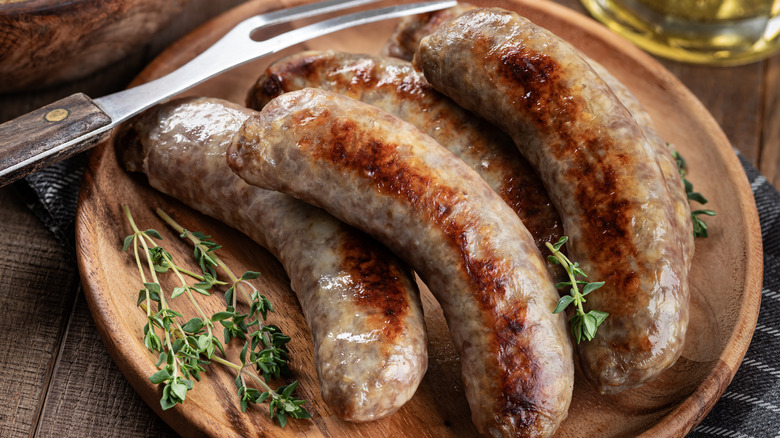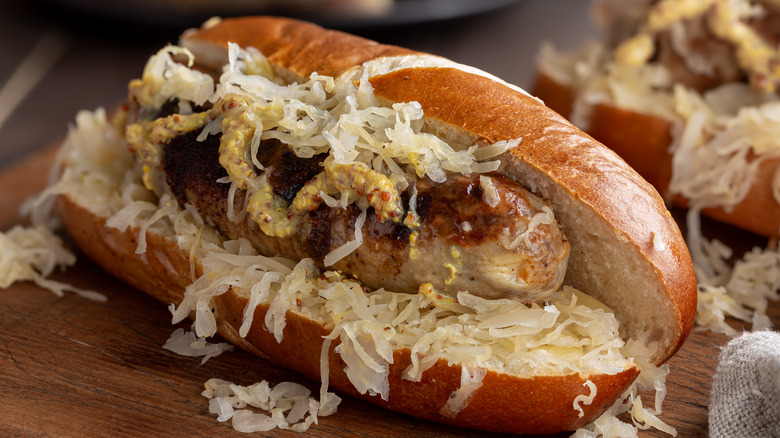Brats And Hot Dogs Aren't The Same. Here Are The Differences
If there's one thing carnivores love, it's meat in tube form. It's important to note, though, that various types of tube meat are different from each other, and nowhere is this more apparent than between bratwurst and hot dogs. Bratwurst and sausage are also different, but not for the same reasons. Bratwurst and hot dogs are both different types of sausage — but a bratwurst is never a hot dog nor vice versa. Really, the main points of overlap is that they're both tubes of meat, and they can both be cooked using generally the same methods (boiling, grilling, smoking, roasting, etc).
Beyond that, though, they diverge pretty significantly. Obviously, you won't confuse the two visually; bratwurst is notably thicker and a greyish-brown color, while hot dogs are long, thin, and distinctly red-pink. The differences go deeper than that, too, as not only are their internal compositions not at all the same either in terms of ingredients and texture, and not only are they prepared differently before being brought to market, but the two don't even originally come from the same country.
Bratwurst are German originally, while hot dogs are American
Though both bratwurst and hot dogs may be globally popular now, their origins are very different. While sausages entered the historical record during the 3rd century CE, the first mention of bratwursts dates to 1313 in Nuremberg, Germany. The etymological theory of its name comes from Old High German words meaning something like "sausage without waste." Despite its Germanic origins, however, bratwurst is now arguably even more popular in the U.S., with Sheboygan, Wisconsin, declared "the bratwurst capital of the world."
Hot dogs, by contrast, didn't have to make their way to America because they started here. Though they're likely descended from another German sausage called the frankfurter, frankfurters and hot dogs are different things. As far as their origins, we're not 100% certain, but the most likely story for hot dogs is that they were first served in their modern form by a pushcart vendor named Charles Feltman in the mid-1800s. They were probably called hot dogs, meanwhile, because they were compared to dachshunds, the short, long canines also now known as "wiener dogs."
Both bratwurst and hot dogs are great cookout meats, but another connection only applies to one of them. While bratwursts don't have a specific cultural activity they're tied to, hot dogs are very closely associated with the sport of baseball, which had a huge hand in popularizing them nationally.
The two have different ingredients and preparations
Hot dogs and bratwurst are processed very differently, too. Bratwurst is generally sold raw, but hot dogs are pre-cooked, making them much faster to prepare. The texture is also different, as bratwurst is generally more coarse and dense, while hot dogs are ground very finely. The reason for this is because of what's in them: While bratwurst is typically made of pure beef, pork, or veal and seasoned with caraway, lemon zest, ginger, nutmeg, or coriander, hot dogs are made of meat trimmings (pork, beef, chicken, turkey, etc) seasoned with garlic, salt, and paprika and emulsified into a paste to create a smooth texture.
Interestingly, while both can be served in a bun, one typically has very distinct toppings in that scenario, while the other is more mutable. Bratwurst's traditional flavor profile is distinctly German, involving sauerkraut and mustard. Hot dogs, though, have tons of potential toppings and tons of regional and national variations, from Chicago-style hot dogs and Sonoran dogs to the Brazilian hot dogs known as "cachorro quentes." While hot dogs are almost always served in a bun, their counterpart may or may not be. It's just as common to eat them grilled in a beer-cooked bratwurst with onions as to toss them in a pretzel roll.


